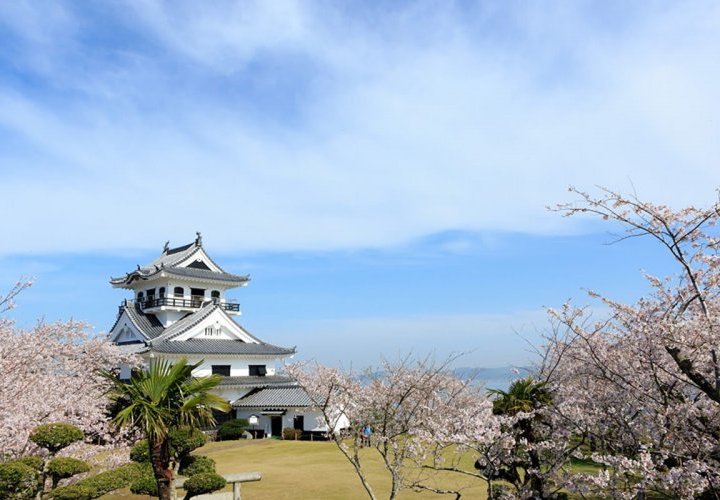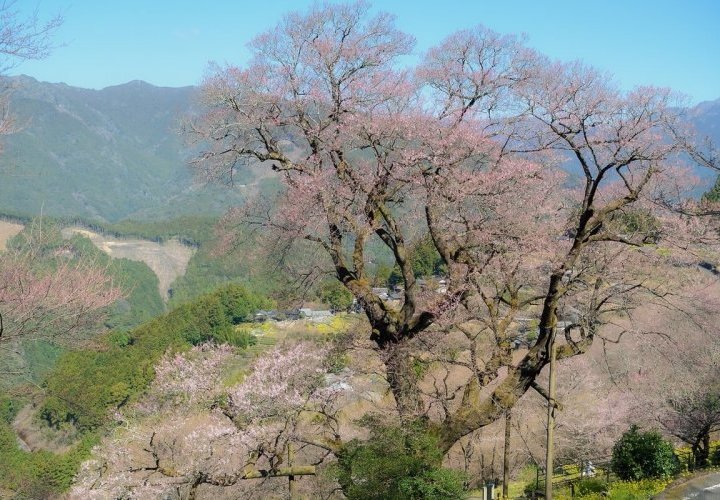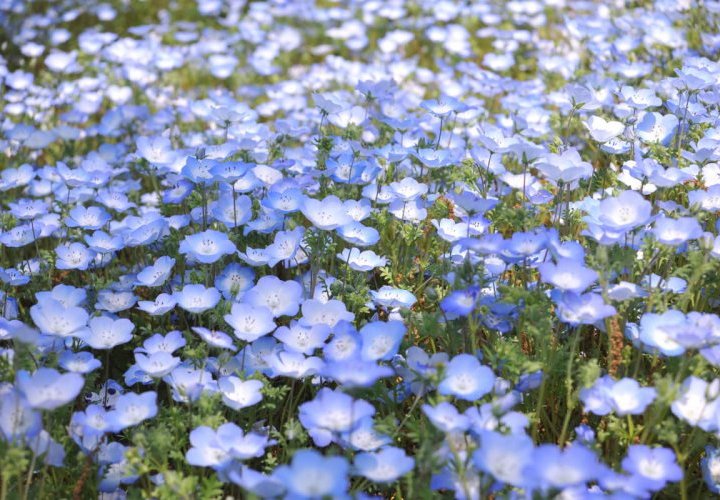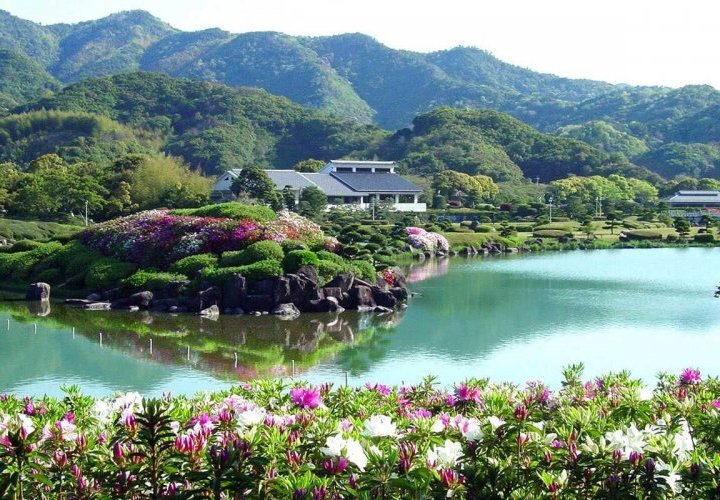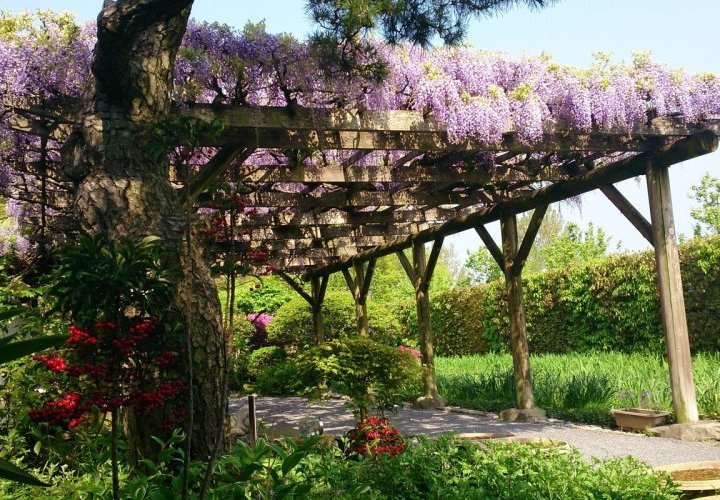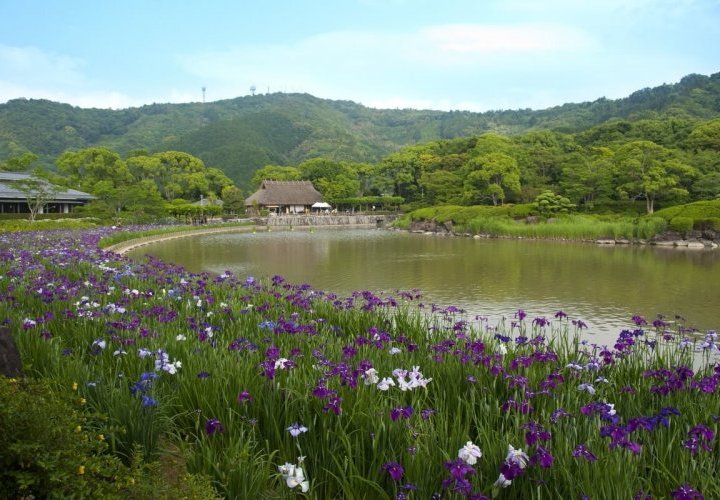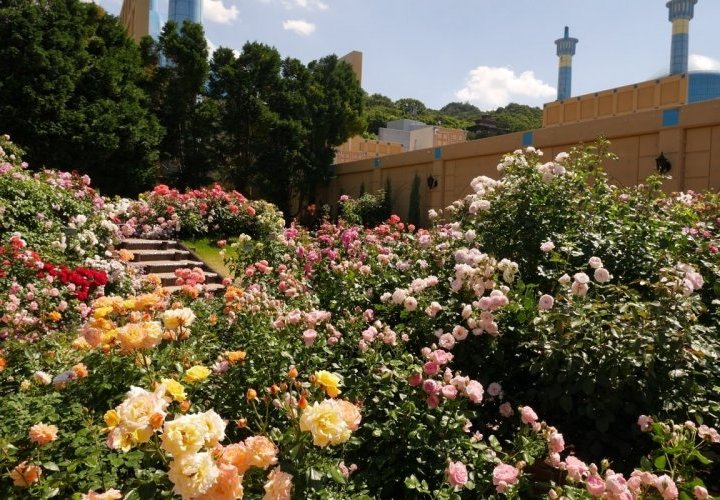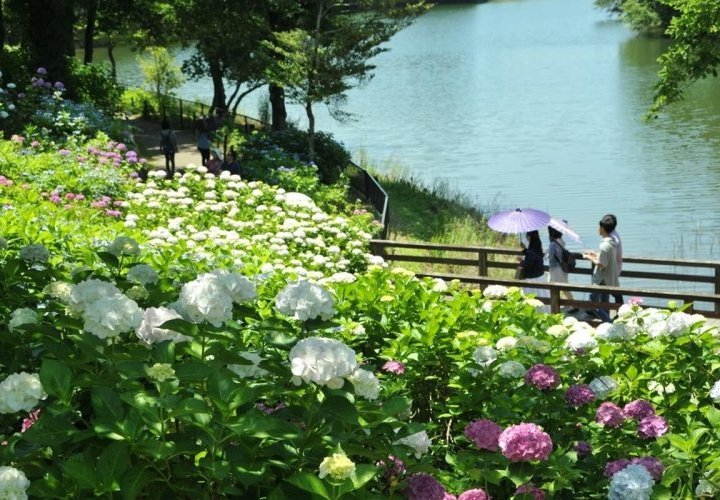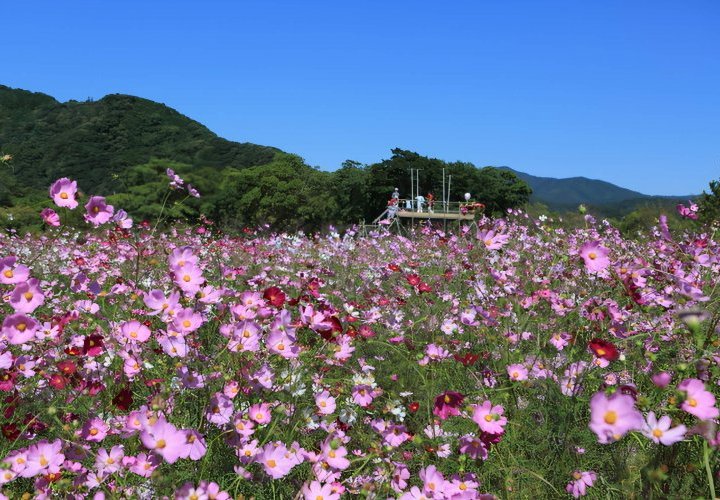Christmas rose in Sanuki Manno National Park, Manno (mid-February to early April)
Christmas rose is an evergreen perennial flowering plant in the buttercup family, Ranunculaceae with about 20 native species known in Europe/Western Asia. Although it does not belong to the rose family (Rosaceae), it earned the name "Christmas rose" because it blooms in the depths of winter and its flowers resemble wild roses. There are about 3,000 Christmas roses in Sanuki Manno National Park that will surely delight your eyes!
Plum in Nanaore Plum Garden, Nanaore, Tobe (late February to early March)
Nanaore Plum Garden is located amongst the mountains along the Prefectural Route 219 in Nanaore, Tobe town. Around 30 varieties of roughly 16, more
Christmas rose is an evergreen perennial flowering plant in the buttercup family, Ranunculaceae with about 20 native species known in Europe/Western Asia. Although it does not belong to the rose family (Rosaceae), it earned the name "Christmas rose" because it blooms in the depths of winter and its flowers resemble wild roses. There are about 3,000 Christmas roses in Sanuki Manno National Park that will surely delight your eyes!
Plum in Nanaore Plum Garden, Nanaore, Tobe (late February to early March)
Nanaore Plum Garden is located amongst the mountains along the Prefectural Route 219 in Nanaore, Tobe town. Around 30 varieties of roughly 16, more
000 plum trees grow and blossom in the park. Every year, from late February to early March, the Nanaore Plum Festival is held here. It features a variety of events, including the sale of processed products made with plums, mochimaki (rice cake giveaways) and other items.
Tulip in Kagami Tulip Park, Kagami (early March to early April)
Kagami Tulip Park located near Kagami station is the largest tulip garden in Shikoku reaching about 1 hectare in size. Over 180 varieties of tulips and over 9 million flowers can be admired in spring in the garden. The great number and varieties of tulips, with different colours and forms, create a spectacular scenery. You can also visit the large wooden playground equipment with swings or take a ride in the train and you will have a lot of fun, as if visiting an amusement park for children.
Daffodil in Sanuki Manno National Park, Manno (mid-March to late March)
About 70 species of daffodil (around 200,000 plants) grow in Sanuki Manno National Park. They start to bloom in March announcing the arrival of spring. Originating from the Mediterranean coast and the Canary Islands, daffodil is currently one of Japan's iconic spring flowers.
Cherry blossoms in Shiroyama Park, Matsuyama (late March to early April)
Shiroyama Park sits within the moat of Matsuyama Castle, a place that is visited by many tourists throughout the year. During spring, it offers the visitors a marvellous cherry blossom view featuring the contrast between the majestic castle tower that was built during the Edo period (1603 – 1867) and the beautiful cherry trees in bloom. This is a really captivating scenery for the eyes.
Cherry blossoms on Mount Shiude, Mitoyo (late March to early April)
Mount Shiude (Shiudeyama in Japanese) is one of the best cherry blossom viewing spots in Japan due to colourful scenery created by the pink hues of its 1,000 cherry trees and the magnificent overlook view of the Seto Inland Sea. The mountain, which is 352 metres high, offers a 360-degree panoramic view that, on clear days, extends up to Shodo Island (Shodoshima) and Chugoku region. On top of that, watching the sunset over the sea will definitely impress you!
Cherry blossoms in Kinbuchi Forest Park, Takamatsu (late March to mid-April)
Kinbuchi Forest Park is located around a quiet lake in Takamatsu city and provides a recreation place for guests, facilities such as an open lawn space, a forest learning exhibition hall, a campground, a kids square, etc. The park has around 5,000 cherry trees in total and in spring, its 500-meter-long main road is the perfect spot to enjoy a walk under the falling cherry blossoms. From the top of Mt. Nikozan rising to 180 meters, you can see the Seto Inland Sea and the city of Takamatsu.
Hyotan Sakura blossoms, Niyodogawa (late March to early April)
Hyotan Sakura is a double weeping rosebud cherry tree that is about 500 years old. The tree is 21 meters in height and was designated as a Prefectural Natural Monument. The tree usually blooms from late March to early April and is called Hyotan Sakura because of its buds that have a shape resembling bottle gourds or hyotan.
Cherry blossoms in Ritsurin Garden, Takamatsu (late March to mid-April)
Ritsurin Garden is a gorgeous park located near Takamatsu city and a great cherry blossom viewing spot to see both the mountains and ocean landscapes. In 2009, it was awarded three stars in the Michelin Green Guide Japan and among its many natural beauties includes around 350 cherry trees. You can see them during the day light reflecting on the surface of the park’s ponds or you can see them lit up at night in late March or early April depending on the year.
Cherry blossoms in Hirakiyama Park, Imabari (early to mid-April)
Hirakiyama Park is located in Imabari city, on the 149-metre tall summit of Hirakiyama. During the spring, there are nearly 1,000 cherry trees in blossom and from the observation deck, you can see three scenic bridges such as Oshima Bridge, Omishima Bridge and Tatara Bridge crossing the Seto Inland Sea. The park is also open in the evening and offers you the possibility to enjoy a nocturnal hanami experience.
Tulip in Kitajima Tulip Park, Kitajima (early to late April)
Located in Kitajima town, Kitajima Tulip Park was designated as one of the “88 Scenic Spots of Tokushima”. The park covers an area of 1,800 square metres and features around 50,000 beautiful tulip flowers of around 80 different varieties.
Wisteria in Tenshaen Garden, Uwajima (early to late April)
Tenshaen Garden was built for the retirement of Munetada Date, the seventh feudal lord of the Uwajma domain and was once a place for reflexion for Uwajima city’s lords. The garden delights visitors with seasonal flowers, its most striking feature being the bridge of wisterias that transforms into a cascade of flowers in April.
Rhododendron in Nanrakuen Garden, Uwajima (early April to early May)
With a total area of 153,322 square metres, Nanrakuen Garden located in Uwajima city is the largest Japanese garden in Shikoku. There are about 200,000 trees of over 180 species growing in the garden area, where visitors can enjoy viewing colourful carp and seasonal flowers. About 32,000 Rhododendron obtusum, Rhododendron hirado azalea and Enkianthus perulatus and about 36,000 Rhododendron indicum blossom all at once in the garden from early April to early May when also the Azalea Festival is held.
Nemophila (baby blue eyes) in Sanuki Manno National Park, Manno (late April to early May)
In spring the visitors of Sanuki Manno National Park can enjoy beautiful landscapes decorated with plants like daffodils, tulips, and nemophilas. From late April to early May, about 300,000 nemophilas are in bloom in the park delighting your eyes with a marvellous blue scenery!
Tulip in Kagami Tulip Park, Kagami (early March to early April)
Kagami Tulip Park located near Kagami station is the largest tulip garden in Shikoku reaching about 1 hectare in size. Over 180 varieties of tulips and over 9 million flowers can be admired in spring in the garden. The great number and varieties of tulips, with different colours and forms, create a spectacular scenery. You can also visit the large wooden playground equipment with swings or take a ride in the train and you will have a lot of fun, as if visiting an amusement park for children.
Daffodil in Sanuki Manno National Park, Manno (mid-March to late March)
About 70 species of daffodil (around 200,000 plants) grow in Sanuki Manno National Park. They start to bloom in March announcing the arrival of spring. Originating from the Mediterranean coast and the Canary Islands, daffodil is currently one of Japan's iconic spring flowers.
Cherry blossoms in Shiroyama Park, Matsuyama (late March to early April)
Shiroyama Park sits within the moat of Matsuyama Castle, a place that is visited by many tourists throughout the year. During spring, it offers the visitors a marvellous cherry blossom view featuring the contrast between the majestic castle tower that was built during the Edo period (1603 – 1867) and the beautiful cherry trees in bloom. This is a really captivating scenery for the eyes.
Cherry blossoms on Mount Shiude, Mitoyo (late March to early April)
Mount Shiude (Shiudeyama in Japanese) is one of the best cherry blossom viewing spots in Japan due to colourful scenery created by the pink hues of its 1,000 cherry trees and the magnificent overlook view of the Seto Inland Sea. The mountain, which is 352 metres high, offers a 360-degree panoramic view that, on clear days, extends up to Shodo Island (Shodoshima) and Chugoku region. On top of that, watching the sunset over the sea will definitely impress you!
Cherry blossoms in Kinbuchi Forest Park, Takamatsu (late March to mid-April)
Kinbuchi Forest Park is located around a quiet lake in Takamatsu city and provides a recreation place for guests, facilities such as an open lawn space, a forest learning exhibition hall, a campground, a kids square, etc. The park has around 5,000 cherry trees in total and in spring, its 500-meter-long main road is the perfect spot to enjoy a walk under the falling cherry blossoms. From the top of Mt. Nikozan rising to 180 meters, you can see the Seto Inland Sea and the city of Takamatsu.
Hyotan Sakura blossoms, Niyodogawa (late March to early April)
Hyotan Sakura is a double weeping rosebud cherry tree that is about 500 years old. The tree is 21 meters in height and was designated as a Prefectural Natural Monument. The tree usually blooms from late March to early April and is called Hyotan Sakura because of its buds that have a shape resembling bottle gourds or hyotan.
Cherry blossoms in Ritsurin Garden, Takamatsu (late March to mid-April)
Ritsurin Garden is a gorgeous park located near Takamatsu city and a great cherry blossom viewing spot to see both the mountains and ocean landscapes. In 2009, it was awarded three stars in the Michelin Green Guide Japan and among its many natural beauties includes around 350 cherry trees. You can see them during the day light reflecting on the surface of the park’s ponds or you can see them lit up at night in late March or early April depending on the year.
Cherry blossoms in Hirakiyama Park, Imabari (early to mid-April)
Hirakiyama Park is located in Imabari city, on the 149-metre tall summit of Hirakiyama. During the spring, there are nearly 1,000 cherry trees in blossom and from the observation deck, you can see three scenic bridges such as Oshima Bridge, Omishima Bridge and Tatara Bridge crossing the Seto Inland Sea. The park is also open in the evening and offers you the possibility to enjoy a nocturnal hanami experience.
Tulip in Kitajima Tulip Park, Kitajima (early to late April)
Located in Kitajima town, Kitajima Tulip Park was designated as one of the “88 Scenic Spots of Tokushima”. The park covers an area of 1,800 square metres and features around 50,000 beautiful tulip flowers of around 80 different varieties.
Wisteria in Tenshaen Garden, Uwajima (early to late April)
Tenshaen Garden was built for the retirement of Munetada Date, the seventh feudal lord of the Uwajma domain and was once a place for reflexion for Uwajima city’s lords. The garden delights visitors with seasonal flowers, its most striking feature being the bridge of wisterias that transforms into a cascade of flowers in April.
Rhododendron in Nanrakuen Garden, Uwajima (early April to early May)
With a total area of 153,322 square metres, Nanrakuen Garden located in Uwajima city is the largest Japanese garden in Shikoku. There are about 200,000 trees of over 180 species growing in the garden area, where visitors can enjoy viewing colourful carp and seasonal flowers. About 32,000 Rhododendron obtusum, Rhododendron hirado azalea and Enkianthus perulatus and about 36,000 Rhododendron indicum blossom all at once in the garden from early April to early May when also the Azalea Festival is held.
Nemophila (baby blue eyes) in Sanuki Manno National Park, Manno (late April to early May)
In spring the visitors of Sanuki Manno National Park can enjoy beautiful landscapes decorated with plants like daffodils, tulips, and nemophilas. From late April to early May, about 300,000 nemophilas are in bloom in the park delighting your eyes with a marvellous blue scenery!
Iris in Sanuki Manno National Park, Manno (early to late May)
Sanuki Manno National Park is filled with many seasonally blooming flowers including the so-called bearded irises because they have soft hairs along the centre of the falls. You can enjoy the beautiful solid-coloured and duotone varieties of bearded irises that are some of the most fashionable seasonal blooms.
Iris in Nanrakuen Garden, Uwajima (early May to early June)
Selected as one of the “Top 100 Urban Parks of Japan”, Nanrakuen Garden is also the largest Japanese garden in Shikoku. It offers a beautiful scenery when many of its plants are in blossom. From early May to early June every year, about 30,000 irises bloom here covering most of the garden and offering impressive views to its visitors. more
Water lily in Dragonfly Nature Park, Shimanto (early May to mid-October)
Every morning, from early May to mid-October, about 3,000 water lilies are in full bloom in the park. During the season when they are in full bloom, special events focused on sale of local products, etc. are held in the park.
Marguerite (daisy) in Flower Park Urashima, Mitoyo (full blossom in May)
Flower Park Urashima located in Mitoyo city, Kagawa Prefecture lets visitors admire a sea of marguerites back dropped by the Seto Inland Sea Islands. Actually, Mitoyo city is the number one production area for marguerites in Japan. This large municipal park is especially popular in May when the marguerites are in full bloom, blanketing one side of the park in pure white colour and enveloping visitors in their scent. In addition to the marguerites, other seasonal flowers including marguerites that can be admired in the park, including marigolds, poppies, cosmoses, evening primroses, etc.
Iris in Dragonfly Natural Park, Shimanto (late May to early June)
Dragonfly Natural Park, which is the world’s first dragonfly sanctuary, pleases its guests with about 10,000 Japanese irises that come into bloom from late May to early June. From early spring to the end of autumn, the dragonflies fly among the seasonal flowers including Japanese irises, water lilies and water peppers.
Rose at New Reoma World, Marugame (late May to mid-July)
New Reoma World amusement park is a park of recreated Asian architectural wonders called Oriental Trip and Reoma Waterland (an outdoor pool only open during the summer). Stunning seasonal flowers span on a distance of nearly 50,000 square metres. About 20,000 roses (around 300 varieties) from around the world come into bloom from May to July on the 1,000 square metre garden at Oriental Trip, Reoma Rose Garden.
Hydrangea in Sanuki Manno National Park, Manno (mid-June to late June)
About 40 hydrangea species totalling 200,000 plants come into bloom from mid-June to late June in the Hydrangea Garden of Sanuki Manno National Park. Japan-native hydrangeas blossom during tsuyu (rainy season) and look beautiful in the rain. During the Hydrangea (Ajisai) Festival that takes place in the park when hydrangeas are in bloom, you can rent a Japanese style umbrella (free of charge) and experience the feel of this Japanese setting.
Hydrangea along Ajisai (Hydrangea) Road and Shimonagase Hydrangea Park, Shikokuchuo (June)
This 15-km stretch of road running from the National Route 319 Houo Tunnel in Shikokuchuo city to the Besshiyama district in Niihama city is a feast for any driver’s eyes due to its hydrangeas. About 30,000 hydrangeas have been planted along this road. A park, Shimonagase Hydrangea Park, was also built along the road and if you have a little time, you can enjoy hydrangea viewing in the park.
Sunflower in Sanuki Manno National Park, Manno (late July to early August)
In summer, you are able to enjoy viewing about 15,000 sunflowers in bloom in Sanuki Manno National Park turning their heads toward the sun. If you come with your children, they will fully enjoy their summer vacation coming from the water playground and “kabuto-mushi” (unicorn beetle) land.
Cosmos in Sanuki Manno National Park, Manno (mid-September to mid-October)
There are about plants about 300,000 cosmos plants of about 10 species in Sanuki Manno National Park. Sulphur or yellow cosmos variety blooms from mid-September to late September, allowing visitors to view a beautiful yellow scenery. Cosmos bipinnatus varieties delight the visitors’ eyes with their pink, purple and white flowers that can be admired from late September to mid-October in the park.
Red spider lily in Nyuta Willow (Yanagi) Forest, Shimanto (late September)
In late September, red spider lilies blossom along the Shimanto River in Nyuta Willow Forest in vivid red colours that are truly breathtaking. You can also take a walk in the natural Willow (Yanagi) Forest that is about 2 km or enjoy the in-season specialities of the region.
Cosmos in Miyanomae Park, Ochi (early to mid-October)
Miyanomae Park is a lovely park filled with more than 1.5 million pieces of cosmos that bloom here every year. The park is about 32,000 square metres and is located near the centre of Ochi town. When the flowers come into full bloom, the park hosts the Cosmos Festival, which features a gigantic cosmos maze (made from part of the flower field) along with various food stalls and other attractions that draw in many tourists.
Sanuki Manno National Park is filled with many seasonally blooming flowers including the so-called bearded irises because they have soft hairs along the centre of the falls. You can enjoy the beautiful solid-coloured and duotone varieties of bearded irises that are some of the most fashionable seasonal blooms.
Iris in Nanrakuen Garden, Uwajima (early May to early June)
Selected as one of the “Top 100 Urban Parks of Japan”, Nanrakuen Garden is also the largest Japanese garden in Shikoku. It offers a beautiful scenery when many of its plants are in blossom. From early May to early June every year, about 30,000 irises bloom here covering most of the garden and offering impressive views to its visitors. more
Water lily in Dragonfly Nature Park, Shimanto (early May to mid-October)
Every morning, from early May to mid-October, about 3,000 water lilies are in full bloom in the park. During the season when they are in full bloom, special events focused on sale of local products, etc. are held in the park.
Marguerite (daisy) in Flower Park Urashima, Mitoyo (full blossom in May)
Flower Park Urashima located in Mitoyo city, Kagawa Prefecture lets visitors admire a sea of marguerites back dropped by the Seto Inland Sea Islands. Actually, Mitoyo city is the number one production area for marguerites in Japan. This large municipal park is especially popular in May when the marguerites are in full bloom, blanketing one side of the park in pure white colour and enveloping visitors in their scent. In addition to the marguerites, other seasonal flowers including marguerites that can be admired in the park, including marigolds, poppies, cosmoses, evening primroses, etc.
Iris in Dragonfly Natural Park, Shimanto (late May to early June)
Dragonfly Natural Park, which is the world’s first dragonfly sanctuary, pleases its guests with about 10,000 Japanese irises that come into bloom from late May to early June. From early spring to the end of autumn, the dragonflies fly among the seasonal flowers including Japanese irises, water lilies and water peppers.
Rose at New Reoma World, Marugame (late May to mid-July)
New Reoma World amusement park is a park of recreated Asian architectural wonders called Oriental Trip and Reoma Waterland (an outdoor pool only open during the summer). Stunning seasonal flowers span on a distance of nearly 50,000 square metres. About 20,000 roses (around 300 varieties) from around the world come into bloom from May to July on the 1,000 square metre garden at Oriental Trip, Reoma Rose Garden.
Hydrangea in Sanuki Manno National Park, Manno (mid-June to late June)
About 40 hydrangea species totalling 200,000 plants come into bloom from mid-June to late June in the Hydrangea Garden of Sanuki Manno National Park. Japan-native hydrangeas blossom during tsuyu (rainy season) and look beautiful in the rain. During the Hydrangea (Ajisai) Festival that takes place in the park when hydrangeas are in bloom, you can rent a Japanese style umbrella (free of charge) and experience the feel of this Japanese setting.
Hydrangea along Ajisai (Hydrangea) Road and Shimonagase Hydrangea Park, Shikokuchuo (June)
This 15-km stretch of road running from the National Route 319 Houo Tunnel in Shikokuchuo city to the Besshiyama district in Niihama city is a feast for any driver’s eyes due to its hydrangeas. About 30,000 hydrangeas have been planted along this road. A park, Shimonagase Hydrangea Park, was also built along the road and if you have a little time, you can enjoy hydrangea viewing in the park.
Sunflower in Sanuki Manno National Park, Manno (late July to early August)
In summer, you are able to enjoy viewing about 15,000 sunflowers in bloom in Sanuki Manno National Park turning their heads toward the sun. If you come with your children, they will fully enjoy their summer vacation coming from the water playground and “kabuto-mushi” (unicorn beetle) land.
Cosmos in Sanuki Manno National Park, Manno (mid-September to mid-October)
There are about plants about 300,000 cosmos plants of about 10 species in Sanuki Manno National Park. Sulphur or yellow cosmos variety blooms from mid-September to late September, allowing visitors to view a beautiful yellow scenery. Cosmos bipinnatus varieties delight the visitors’ eyes with their pink, purple and white flowers that can be admired from late September to mid-October in the park.
Red spider lily in Nyuta Willow (Yanagi) Forest, Shimanto (late September)
In late September, red spider lilies blossom along the Shimanto River in Nyuta Willow Forest in vivid red colours that are truly breathtaking. You can also take a walk in the natural Willow (Yanagi) Forest that is about 2 km or enjoy the in-season specialities of the region.
Cosmos in Miyanomae Park, Ochi (early to mid-October)
Miyanomae Park is a lovely park filled with more than 1.5 million pieces of cosmos that bloom here every year. The park is about 32,000 square metres and is located near the centre of Ochi town. When the flowers come into full bloom, the park hosts the Cosmos Festival, which features a gigantic cosmos maze (made from part of the flower field) along with various food stalls and other attractions that draw in many tourists.

